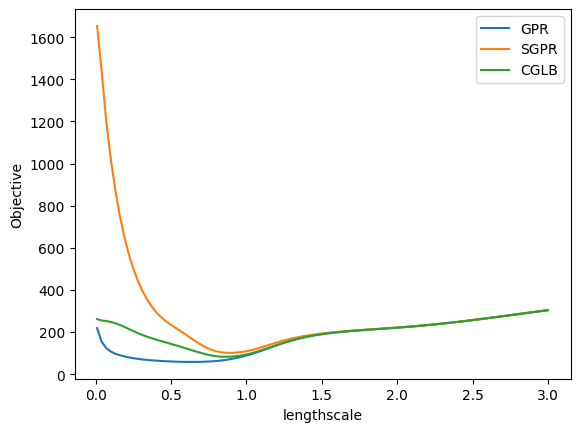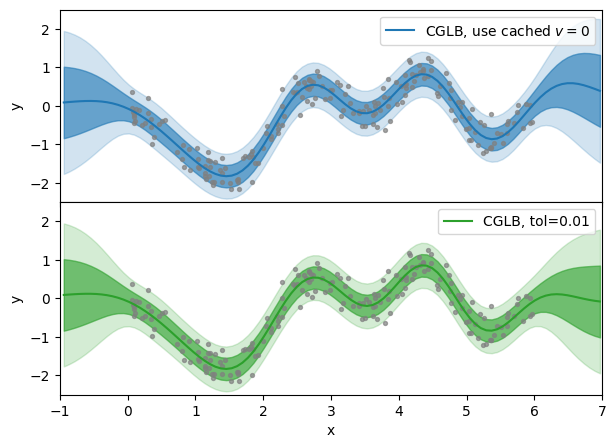[1]:
import matplotlib.pyplot as plt
import numpy as np
import tensorflow as tf
from cglb import load_snelson_data, plot_prediction
from gpflow.kernels import SquaredExponential
from gpflow.models import CGLB, GPR, SGPR
from gpflow.optimizers import Scipy
2023-08-09 12:26:55.652247: W tensorflow/compiler/tf2tensorrt/utils/py_utils.cc:38] TF-TRT Warning: Could not find TensorRT
[2]:
%matplotlib inline
Conjugate Gradient Lower Bound#
First, we load the snelson1d training dataset.
[3]:
data = load_snelson_data()
The CGLB model introduces less bias in comparison to SGPR model. We can show empirically that CGLB has a lower bias by plotting the objective landscape with respect to different values of the lengthscale hyperparameters.
[4]:
x, y = data
n = x.shape[0]
m = 10
iv_indices = np.random.choice(range(n), size=m, replace=False)
iv = x[iv_indices, :]
noise = 0.1
gpr = GPR(data, kernel=SquaredExponential(), noise_variance=noise)
cglb = CGLB(
data,
kernel=SquaredExponential(),
noise_variance=noise,
inducing_variable=iv,
)
sgpr = SGPR(
data,
kernel=SquaredExponential(),
noise_variance=noise,
inducing_variable=iv,
)
def loss_with_changed_parameter(model, parameter, value: float):
original = parameter.numpy()
parameter.assign(value)
loss = model.training_loss()
parameter.assign(original)
return loss.numpy()
ls = np.linspace(0.01, 3, 100)
losses_fn = lambda m: [
loss_with_changed_parameter(m, m.kernel.lengthscales, l) for l in ls
]
gpr_obj = losses_fn(gpr)
sgpr_obj = losses_fn(sgpr)
cglb_obj = losses_fn(cglb)
plt.plot(ls, gpr_obj, label="GPR")
plt.plot(ls, sgpr_obj, label="SGPR")
plt.plot(ls, cglb_obj, label="CGLB")
plt.xlabel("lengthscale")
plt.ylabel("Objective")
plt.legend()
plt.show()

The interface of CGLB model is similar to SGPR, however, it has extra options related to the conjugate gradient which is involved in the computation of $ yᵀK⁻¹y $. * cg_tolerance. This is the expected maximum error in the solution produced by the conjugate gradient, i.e. the ϵ threshold of the stopping criteria in the CG loop: $ rᵀQ⁻¹r < 0.5ϵ $. The default value for cg_tolerance is $ 1.0 $. It is a good working value for model training, which has been confirmed in practice. The
predict_f, predict_log_density, and predict_y methods have their own cg_tolerance options as for predictions you might want to tighten up the CG solution closer to exact. * max_cg_iters. The maximum number of CG iterations. * restart_cg_step. The frequency with wich the CG resets the internal state to the initial position using current solution vector v. * v_grad_optimization. CGLB introduces auxiliary parameter v, and by default optimal v is found with
the CG. However you can include v into the list of trainable model parameters.
[5]:
cglb = CGLB(
data,
kernel=SquaredExponential(),
noise_variance=noise,
inducing_variable=iv,
cg_tolerance=1.0,
max_cg_iters=50,
restart_cg_iters=50,
)
opt = Scipy()
We train the model as usual. Variables do not include the $ v $ auxiliary vector.
[6]:
variables = cglb.trainable_variables
opt.minimize(
cglb.training_loss_closure(compile=False),
variables,
compile=False,
options=dict(maxiter=100),
)
Below we compare prediction results for different CG tolerances. The cg_tolerance=None means that no CG is run to tune the $ v $ vector, and cg_tolerance=0.01 is much lower value than the one used at the model optimization.
The 1D dataset which we use is too simple and it would be hard to see the difference in mean prediction of the model. As a demonstration we reset the $ v $ auxiliary vector to zero, so that predictions are identical to SGPR.
[7]:
v = tf.zeros_like(cglb.aux_vec)
cglb.aux_vec.assign(v)
[7]:
<tf.Variable 'UnreadVariable' shape=(1, 200) dtype=float64, numpy=
array([[0., 0., 0., 0., 0., 0., 0., 0., 0., 0., 0., 0., 0., 0., 0., 0.,
0., 0., 0., 0., 0., 0., 0., 0., 0., 0., 0., 0., 0., 0., 0., 0.,
0., 0., 0., 0., 0., 0., 0., 0., 0., 0., 0., 0., 0., 0., 0., 0.,
0., 0., 0., 0., 0., 0., 0., 0., 0., 0., 0., 0., 0., 0., 0., 0.,
0., 0., 0., 0., 0., 0., 0., 0., 0., 0., 0., 0., 0., 0., 0., 0.,
0., 0., 0., 0., 0., 0., 0., 0., 0., 0., 0., 0., 0., 0., 0., 0.,
0., 0., 0., 0., 0., 0., 0., 0., 0., 0., 0., 0., 0., 0., 0., 0.,
0., 0., 0., 0., 0., 0., 0., 0., 0., 0., 0., 0., 0., 0., 0., 0.,
0., 0., 0., 0., 0., 0., 0., 0., 0., 0., 0., 0., 0., 0., 0., 0.,
0., 0., 0., 0., 0., 0., 0., 0., 0., 0., 0., 0., 0., 0., 0., 0.,
0., 0., 0., 0., 0., 0., 0., 0., 0., 0., 0., 0., 0., 0., 0., 0.,
0., 0., 0., 0., 0., 0., 0., 0., 0., 0., 0., 0., 0., 0., 0., 0.,
0., 0., 0., 0., 0., 0., 0., 0.]])>
[8]:
k = 100
xnew = np.linspace(x.min() - 1.0, x.max() + 1.0, k).reshape(-1, 1)
pred_no_tol = cglb.predict_y(xnew, cg_tolerance=None)
pred_tol = cglb.predict_y(xnew, cg_tolerance=0.01)
fig, axes = plt.subplots(2, 1, figsize=(7, 5), sharex=True)
fig.subplots_adjust(hspace=0.0)
x, y = x.squeeze(), y.squeeze()
xnew = xnew.squeeze()
mu_no_tol = pred_no_tol[0].numpy().squeeze()
std_no_tol = np.sqrt(pred_no_tol[1].numpy().squeeze())
plot_prediction(
axes[0],
x,
y,
xnew,
mu_no_tol,
std_no_tol,
"tab:blue",
"CGLB, use cached $v=0$",
)
mu_tol = pred_tol[0].numpy().squeeze()
std_tol = np.sqrt(pred_tol[1].numpy().squeeze())
plot_prediction(
axes[1], x, y, xnew, mu_tol, std_tol, "tab:green", "CGLB, tol=0.01"
)
axes[0].legend()
axes[1].legend()
axes[0].set_xlim([-1, 7])
axes[1].set_xlim([-1, 7])
axes[0].set_ylim([-2.5, 2.5])
axes[1].set_ylim([-2.5, 2.5])
axes[0].set_ylabel("y")
axes[1].set_ylabel("y")
axes[1].set_xlabel("x")
plt.show()
